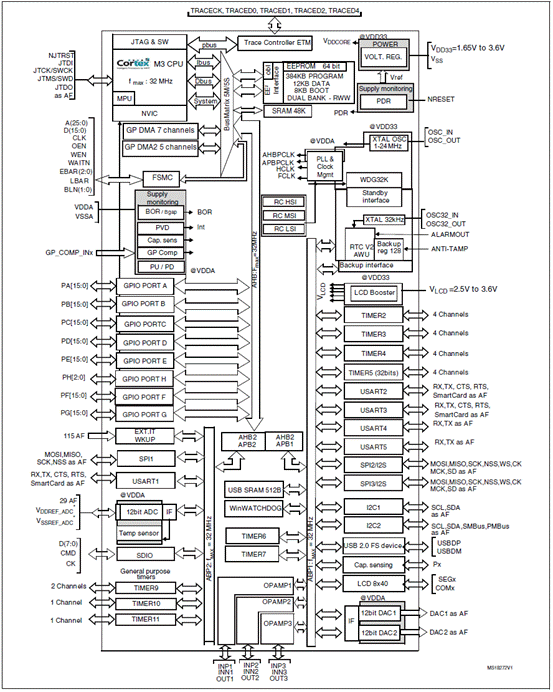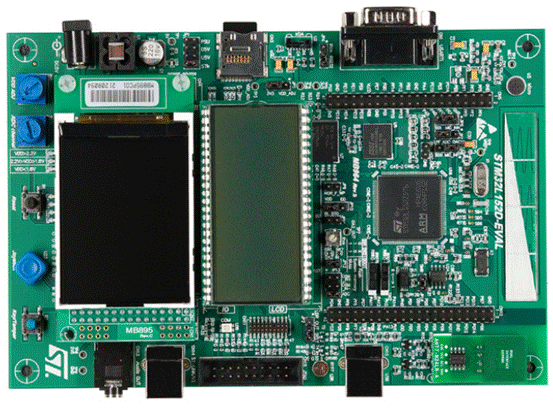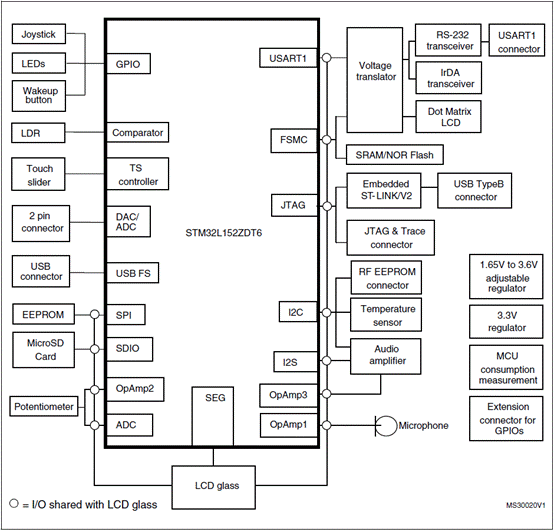ST STM32L152ZD超低功耗ARM Cortex-M3 MCU开发方案
 136
136
 拍明
拍明
原标题:ST STM32L152ZD超低功耗ARM Cortex-M3 MCU开发方案
ST 公司的STM32L152ZD是超低功耗ARM Cortex-M3 MCU,集成了384KB闪存,32MHz CPU(峰值性能33.3 DMIPS peak (Dhrystone 2.1)),LCD,USB和三个运放.工作电压1.8V到3.6V,有7种低功耗模式,待机功耗300nA,主要用在医疗和手持设备,应用控制和用户接口,PC外设,游戏,GPS和运动设备,告警系统,有线和无线传感器,视频连接和实用计量表.本文介绍了STM32L15xxD系列主要特性, 方框图,STM32L152D-EVAL评估板主要特性,方框图,电路图和材料清单.
STM32L152ZD:Ultra-low-power ARM Cortex-M3 MCU with 384 Kbytes Flash, 32 MHz CPU, LCD, USB, 3xOp-amp.
The ultralow power STM32L15xxD family includes devices in 4 different package types: from 64 pins to 144 pins. Depending on the device chosen, different sets of peripherals are included, the description below gives an overview of the complete range of peripherals proposed in this family.
These features make the ultralow power STM32L15xxD microcontroller family suitable for a wide range of applications:
● Medical and handheld equipment
● Application control and user interface
● PC peripherals, gaming, GPS and sport equipment
● Alarm systems, wired and wireless sensors, Video intercom
● Utility metering
The ultralow power STM32L15xxD incorporates the connectivity power of the universal serial bus (USB) with the high-performance ARM Cortex™-M3 32-bit RISC core operating at a 32 MHz frequency, a memory protection unit (MPU), high-speed embedded memories (Flash memory up to 384 Kbytes and RAM up to 48 Kbytes), a flexible static memory controller (FSMC) interface (for devices with packages of 100 pins and more) and an extensive range of enhanced I/Os and peripherals connected to two APB buses.
The STM32L15xxD devices offer three operational amplifiers, one 12-bit ADC, two DACs, two ultralow power comparators, one general-purpose 32-bit timer, six general-purpose 16- bit timers and two basic timers, which can be used as time bases.
Moreover, the STM32L15xxD devices contain standard and advanced communication interfaces: up to two I2Cs, three SPIs, two I2S, one SDIO, three USARTs, two UARTs and a USB. Up to 36 channels are available for capacitive sensing directly driven through GPIOs and general purpose timers. They also include a real-time clock and a set of backup registers that remain powered in Standby mode.
Finally, the integrated LCD controller has a built-in LCD voltage generator that allows you to drive up to 8 multiplexed LCDs with contrast independent of the supply voltage.
The ultralow power STM32L15xxD operates from a 1.8 to 3.6 V power supply (down to 1.65 V at power down) with BOR and from a 1.65 to 3.6 V power supply without BOR option.
It is available in the -40 to +85 °C temperature range. A comprehensive set of power-saving modes allows the design of low-power applications.
STM32L15xxD系列主要特性:
■ Operating conditions
– Operating power supply range: 1.65 V to 3.6 V (without BOR) or 1.8 V to 3.6 V
■ Low power features
– 7 modes: Sleep, Low-power run (11 μA at 32 kHz) , Low-power sleep (4.4 μA), Stop with RTC, Stop (650 nA), Standby with RTC, Standby (300 nA)
–Dynamic core voltage scaling down to 233 μA/MHz
–Ultralow leakage per I/O: 50 nA max
–Fast wakeup time from Stop: 8 μs
–Three wakeup pins
■ Core: ARM 32-bit Cortex™-M3 CPU
– 32 MHz maximum frequency, 33.3 DMIPS peak (Dhrystone 2.1)
– Memory protection unit
■ Reset and supply management
– Low power, ultrasafe BOR (brownout reset)
– Ultralow power POR/PDR
– Programmable voltage detector (PVD)
■ Clock management
– 1 to 24 MHz crystal oscillator
– 32 kHz oscillator for RTC with calibration
– Internal 16 MHz factory-trimmed RC
– Internal 37 kHz low consumption RC
– Internal multispeed low power RC, 65 kHz to 4.2 MHz
– PLL for CPU clock and USB (48 MHz)
■ Memories
– 384 Kbytes of Flash memory with ECC, split into two banks allowing Read While Write
– 12 Kbytes of data EEPROM with ECC
– NVM in 2 banks enabling Read While Write
– 48 Kbytes of RAM
– Flexible static memory controller that supports SRAM, PSRAM and NOR Flash
■ Low power calendar RTC
– Alarm, periodic wakeup from Stop/Standby
■ Up to 116 fast I/Os (102 of which are 5 Vtolerant)
■ DMA: 12-channel DMA controller
■ LCD 8 × 40 or 4 × 44 with step-up converter
■ 3 operational amplifiers
■ 12-bit ADC up to 1 Msps and 40 channels
– Operational amplifier output, temperature sensor and internal voltage reference
– Operates down to 1.8 V
■ Two 12-bit DACs with output buffers
■ Two ultralow power comparators
– Window mode and wakeup capability
■ 11 timers: one 32-bit and six 16-bit generalpurpose timers, two 16-bit basic timers, two watchdog timers (independent and window)
■ Up to 12 communication interfaces
– Up to two I2C interfaces (SMBus/PMBus)
– Up to five USARTs
– Up to three SPIs (16 Mbit/s), two with I2S
– USB 2.0 full-speed interface
– SDIO interface
■ Up to 36 capacitive sensing channels supporting touch, proximity, linear and rotary sensors
■ 32-bit CRC calculation unit, 96-bit unique ID

图1.超低功耗STM32L15xxD方框图
STM32L152D-EVAL评估板
The STM32L152D-EVAL evaluation board is a complete demonstration and development platform for STMicroelectronic’s ARM cortex-M3 core-based STM32L152ZDT6 microcontroller featuring two I2C, three SPI, five USART, 12-bit ADC, 12-bit DAC, LCD driver, internal 48 KB SRAM and 384 KB Flash, touch sensing, USB FS, LCD controller, FSMC and JTAG debugging support.
This board can be used as reference design for user application development but it is not considered as final application. The full range of hardware features on the board helps you evaluate all peripherals (USB FS, USART, audio DAC, microphone ADC, dot-matrix LCD, LCD glass, IrDA, LDR, SRAM, NOR Flash, MicroSD Card, temperature sensor and so on) and develop your own applications. Extension headers make it possible to easily connect a daughterboard or wrapping board for your specific application. An ST-LINK/V2 is integrated on the board as embedded in-circuit debugger and programmer for the STM32 MCU.

图2.STM32L152D-EVAL评估板外形图
STM32L152D-EVAL评估板主要特性:
● Four 5 V power supply options: Power jack, ST-LINK/V2 USB connector, user USB connector or daughterboard
● Audio jack connected to I2S DAC, or STM32L152ZDT6 internal DAC
● Microphone connected to ADC using integrated op amp as amplifier
● 2 GByte (or more) MicroSD Card on SDIO interface
● Temperature sensor and RF EEPROM on I2C compatible serial interface
● RS-232 interface configurable for communication or Flashloader
● IrDA transceiver
● JTAG and trace debug support, embedded ST-LINK/V2
● 4 Kbit serial Flash, 512K x16-bit SRAM and 128 Mbit NOR Flash
● 240x320 TFT color LCD connected to FSMC interface of STM32L152ZDT6
● Joystick with 4-direction control and selector
● Reset and Tamper or key button
● 4 color user LEDs and 3 LEDs as MCU power range indicator
● MCU consumption measurement circuit
● LCD glass 40 x 8 segments connected to LCD driver of STM32L152ZDT6
● Extension connector for daughterboard or wrapping board
● MCU voltage choice of 3.3 V or adjustable from 1.65 V to 3.6 V
● USB FS connector
● Touch slider
● Light dependent resistor (LDR)
● One MCU integrated op amp configured as Sallen-Key 2nd order low pass filter
● One MCU integrated op amp configured as amplifier with adjustable gain
● One ADC / DAC input signal connector
● Potentiometer

图3.STM32L152D-EVAL评估板方框图
责任编辑:HanFeng
【免责声明】
1、本文内容、数据、图表等来源于网络引用或其他公开资料,版权归属原作者、原发表出处。若版权所有方对本文的引用持有异议,请联系拍明芯城(marketing@iczoom.com),本方将及时处理。
2、本文的引用仅供读者交流学习使用,不涉及商业目的。
3、本文内容仅代表作者观点,拍明芯城不对内容的准确性、可靠性或完整性提供明示或暗示的保证。读者阅读本文后做出的决定或行为,是基于自主意愿和独立判断做出的,请读者明确相关结果。
4、如需转载本方拥有版权的文章,请联系拍明芯城(marketing@iczoom.com)注明“转载原因”。未经允许私自转载拍明芯城将保留追究其法律责任的权利。
拍明芯城拥有对此声明的最终解释权。




 产品分类
产品分类















 2012- 2022 拍明芯城ICZOOM.com 版权所有 客服热线:400-693-8369 (9:00-18:00)
2012- 2022 拍明芯城ICZOOM.com 版权所有 客服热线:400-693-8369 (9:00-18:00)


